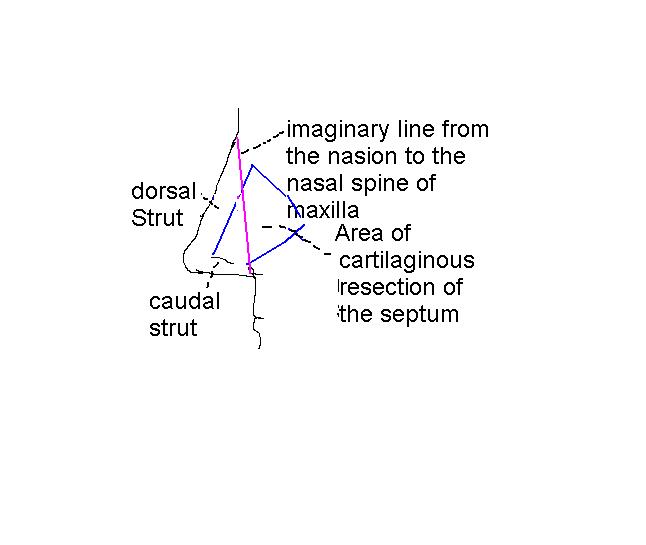|
|

The imaginary vertical line that divides the cartilaginous septum
A vertical line drawn from the nasion to the nasal spine of maxilla divides the cartilaginous nose into an anterior and posterior half.The anterior half is essential to maintain the integrity of the external architecture of the nose...deviations here are dealt with septoplasty, in which an infferior strip of cartilage is resected, cross hatching incisions made on the cartilage to break the spring of the remaining cartilage memory such that it springs back into the midline and inserts into the maxillary crest. Deviations in the posterior half are dealt with by SMR or submucosal resection of the nasal septum in which the deviated segment is resected using the Ballenger swivel knife.Since this area is not crucial to maintain hte external architecture , it can safely be resected after 18 years of age. SMR cannot be done at less than 18yrs of age since this area contains a groth center which continues to grow till 18yrs and is essential to the development of the mid third of the face.Therefore, performing SMR at less than 18yrs will cause developmental hypoplasia of the mid third of the face.
Consequently, deviations in the posterior half of the septal cartilage , if causing symptoms at less than 18yrs of age are dealt with septoplasty.
|
Killians Self retaining nasal speculum
Access to the nasal septum is obtained using the killians self retaing nasal speculum.If there is no self retaing screw , its called the Pilchards Nasal speculum |
|
|
|
Thudicum's nasal speculum
Thiis is how it is to be held,with the thumb and index finger, with the middle and ring finger compresseing the stems so that the flages approximate to insert into the nostril. |
The Ballenger swivel knife
This has got two angulated parallel horizontal arms with a revolving knife attached to its end.This arangement allows one to make a cut in the septum a few millmeteres from the dorsum using the metzenbaum scissors,insert the ballenger swivel knife into the cut, push deep parallel to the dorsum, therby making the horizontal cut, then pull down making the vertical cut in the cartilage and then pull outwards, making the final horizontal cut in order to resect a quadrilateral plate of cartilge(the submucosal resection of the cartilage) |
|
|
|
Close up view of the ballenger swivel knife...the revolving swivel knife attached the end of the parallel horizontal arms
|
The Killians bayonet shaped nasal gouge
This is angled like a bayonet(known as a bayonet becuse this concept of attaching a kinfe to a rifle was conceived in the french town of Bayon) in order to get a good view of the maxillary crest...otherwise if it is straingt, the hand will come in the way and obstruct vision.The edge of the instrument is V shaped to anchor it on the nasal spine and then gouge out the deflected maxillary crest using a mallet(called a mallet because a smillar looking wooden devise used to play a ball and racket game in a shopping mall.hence a mallet!!) |
|
|
|
showing how killians nasal gouge is to be held
|
Mallet
Used to remove the maxillary crest |
|
|
|
Lucs forceps
used to extract the resected septal cartilage |
Killians mucoperichondrial elevator
After the incision is made a few mm from the free edge of the septum called the killians incision, the mucoperichondrial flap is elevated on one side using the killians mucoperichondrial elevator.Then another incision is made through the cartilage, without incising the mucoperichondrium on the other side.Then the mucoperichodrial flap is elevated on the other side too, in order to isolate the bare glistening white cartilage between the flanges of the nasal speculum as seen in the next picture. |
|
|
|
Making the incision using the no 15 Bard parker knife
|
elevating the mucoperichondrium using the killians mucoperichondrial elevetor
|
|
|
|
isolating the cartilage by elevating the mucoperichondrium on the other side too after incising through the cartilge and then getting the cartilage between the flanges of the nasal speculum
|
resecting the deflected cartilage using the ballenger swivel knife, leaving behing a dorsal and a caudal strut
After the resected cartilage is extracted, the mucoperichondrial flaps are kept in apposition by packing the nose either with a medicated ribbon gauze, half inch wide, one meter long or using finger glove packing. This is done after suturing the incision site using 5/8th circle ,16mm needled suture, swaged(means the end of the needle is directly attached to the 3.0 chromic catgut)needle. (conceived by george merson and therfore called mersuture) |
|


